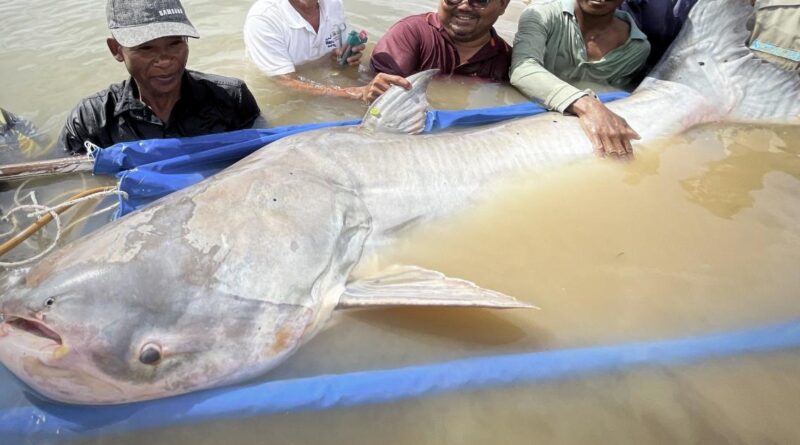6 endangered Mekong giant catfish — one of the world’s largest and rarest freshwater fish — spotted in Cambodia
Six critically endangered Mekong giant catfish — one of the largest and rarest freshwater fish in the world — were caught and released recently in Cambodia, reviving hopes for the survival of the species.
The underwater giants can grow up to 10 feet long and weigh up to 660 pounds, or as heavy as a grand piano. They now are only found in Southeast Asia’s Mekong River but in the past inhabited the length of the 3,044 mile-long river, all the way from its outlet in Vietnam to its northern reaches in China’s Yunnan province.
The species’ population has plummeted by 80% in recent decades due to rising pressures from overfishing, dams that block the migratory path the fish follow to spawn and other disruptions. According to the World Wildlife Fund, some experts believe there may only be a few hundred Mekong giant catfish surviving.
Chhut Chheana/USAID Wonders of the Mekong Handout via REUTERS
Few of the millions of people who depend on the Mekong for their livelihoods have ever seen a giant catfish. To find six of the giants, which were caught and released within 5 days, is unprecedented.
The first two were on the Tonle Sap river, a tributary of the Mekong not far from Cambodian capital Phnom Penh. They were given identification tags and released. On Tuesday, fishermen caught four more giant catfish including two longer than 6.5 feet that weighed 264 pounds and 288 pounds, respectively. The captured fish were apparently migrating from their floodplain habitats near Cambodia’s Tonle Sap Lake northward along the Mekong River, likely to spawning grounds in northern Cambodia, Laos or Thailand.
“It’s a hopeful sign that the species is not in imminent, like in the next few years, risk of extinction, which gives conservation activities time to be implemented and to continue to bend the curve away from decline and toward recovery,” said Dr. Zeb Hogan, a University of Nevada Reno research biologist who leads the U.S. Agency for International Development-funded Wonders of the Mekong project.
Much is still unknown about the giant fish, but over the past two decades a joint conservation program by the Wonders of the Mekong and the Cambodian Fisheries Administration has caught, tagged and released around 100 of them, gaining insights into how the catfish migrate, where they live and the health of the species.
“This information is used to establish migration corridors and protect habitats to try to help these fish survive in the future,” said Hogan.
Zeb Hogan, USAID Wonders of the Mekong Project via AP
The Mekong giant catfish is woven into the region’s cultural fabric, depicted in 3,000-year-old cave paintings, revered in folklore and considered a symbol of the river, whose fisheries feed millions and are valued at $10 billion annually.
Local communities play a crucial role in conservation. Fishermen now know about the importance of reporting accidental catches of rare and endangered species to officials, enabling researchers to reach places where fish have been captured and measure and tag them before releasing them.
“Their cooperation is essential for our research and conservation efforts,” Heng Kong, director of Cambodia’s Inland Fisheries Research and Development Institute, said in a statement.
Apart from the Mekong giant catfish, the river is also home to other large fish including the salmon carp, which was thought to be extinct until it was spotted earlier this year, and the giant sting ray.
That four of these fish were caught and tagged in a single day is likely the “big fish story of the century for the Mekong”, said Brian Eyler, director of the Washington-based Stimson Center’s Southeast Asia Program. He said that seeing them confirms that the annual fish migration was still robust despite all the pressures facing the environment along the Mekong.
“Hopefully what happened this week will show the Mekong countries and the world that the Mekong’s mighty fish population is uniquely special and needs to be conserved,” he said.
Threats to endangered aquatic species
Besides overfishing and plastic pollution, the Mekong River Basin has been degraded by upstream dams and climate change, which have had a major impact on water levels in the critically endangered catfish’s aquatic home.
According to WWF, threats to the Mekong giant catfish include infrastructure development such as dams that block migration routes.
“Without the ability to move up and down rivers, the fish have fewer opportunities to breed,” WWF says.
Zeb Hogan/USAID Wonders of the Mekong Handout via REUTERS
Cambodia has placed tough restrictions on fishing in the vast river to try and reduce the number of endangered aquatic species killed in nets.
Numbers of Irrawaddy dolphins — which once swam through much of the mighty Mekong — have dwindled despite efforts to preserve them.
In 2022, Cambodian fishermen got a shock when they inadvertently hooked an endangered giant freshwater stingray four metres (13 feet) long and weighing 180 kilos.
Over the past 25 years, the CFA and researchers tagged and released around 100 giant catfish as part of a conservation program that encourages fishermen to report catches of rare species.
Conservationists said the recent giant catfish catches mark “a new era of conservation” and “new hope for the survival of a species that has become increasingly rare in much of its native habitat”.
Agence France-Presse contributed to this report.








